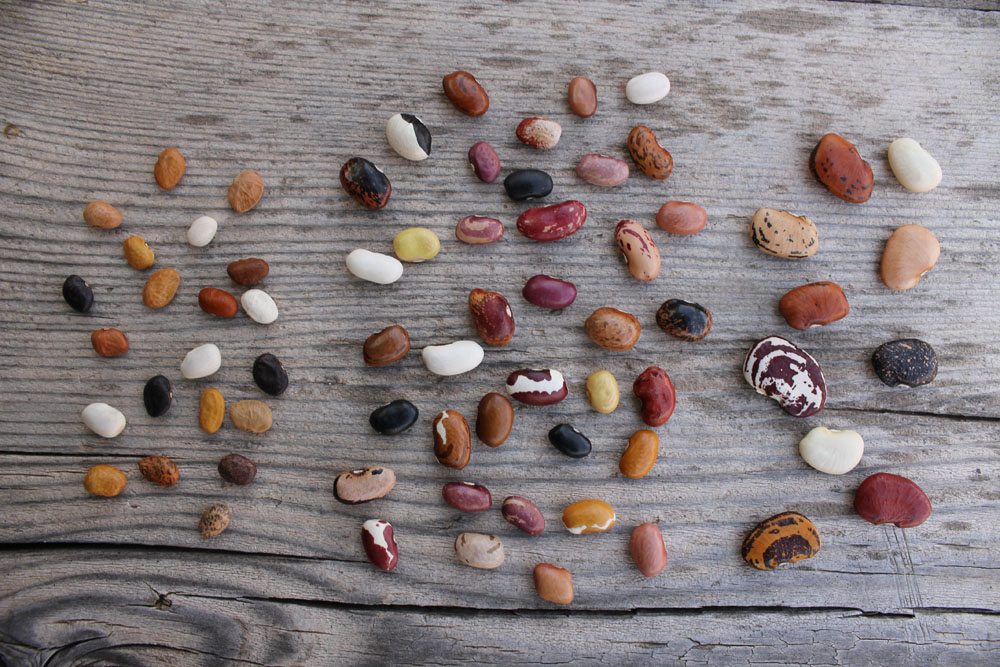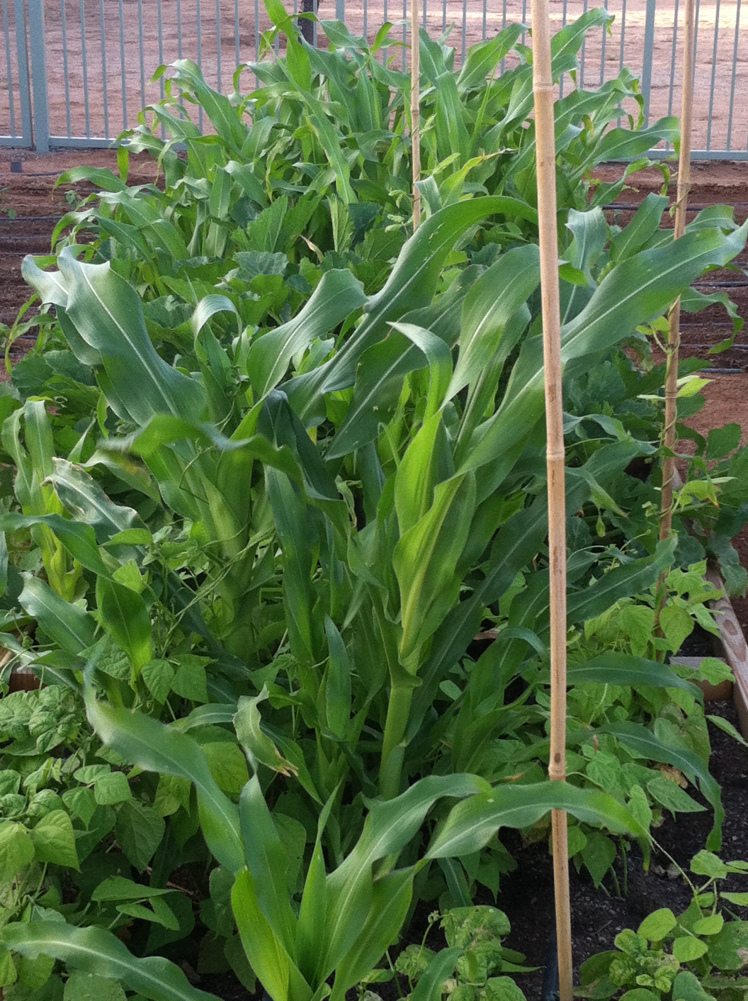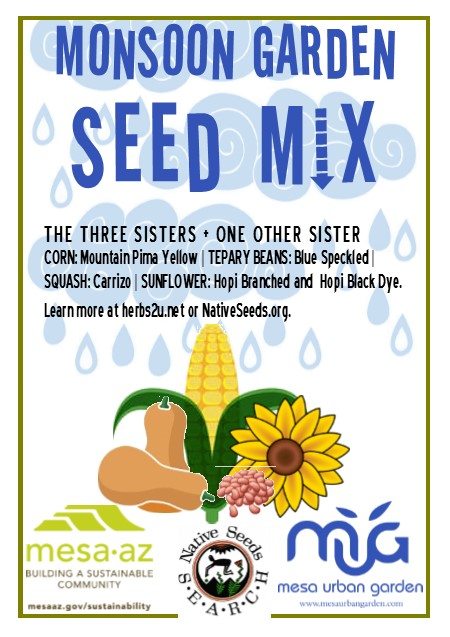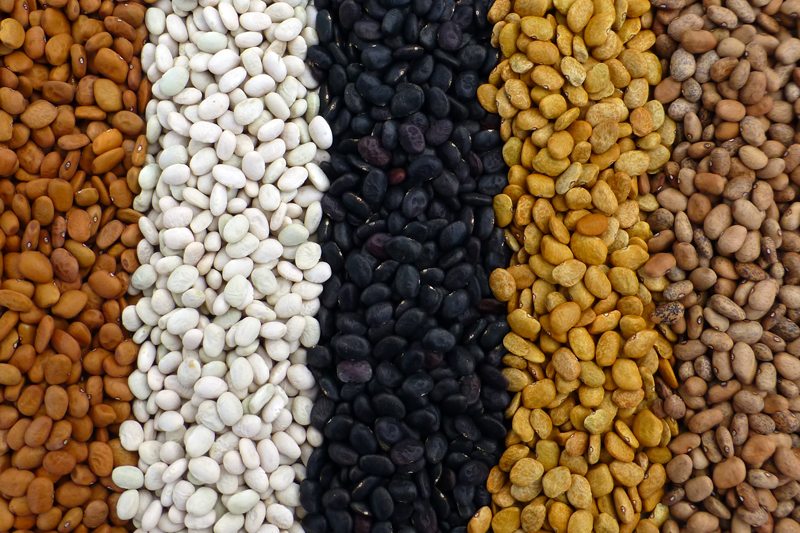The summer rainy season is here, making it a great time to get out in the garden and do some planting! For many seed varieties in the Native Seeds/SEARCH collection, this is a traditional time to plant. The monsoons allow for a second summer season after crops planted in March and early April have matured and been harvested. These varieties have adapted over the centuries to the burst of seasonal moisture and warm temperatures of late June, July, and August. So get out there and start planting!
If you’re curious about what are good options for monsoon planting, simply remember your ABC’s (Amaranth, Beans, Corn, and squash). There are lots of other monsoon options but these crops really shine during this season. Varieties of particular note are those that are from southern Arizona and northwest Mexico (where the North American Monsoon season is most prevalent) and that have been selected by the cultures and traditions of the peoples who occupy the region, such as the Tohono O’odham, who have been growing these plants with the monsoons for centuries. These selections have a short growing season and are able to maximize the few months of moist weather and require little supplemental water if the rains are prevalent. If you live outside of the low desert regions of Southern Arizona, this time of year might be too late for you to plant. Consult your local planting calendars and make sure you have at least 3-4 months before there is a threat of frost.
 An amaranth like Mountain Pima Greens will give you summer greens if you pick the young leaves, and will bring in the pollinators when it comes to flowering time (not to mention bringing beauty to your garden). Amaranth loves the heat and is one of the few greens that you can grow in the summer that won’t require an excessive amount of water or taste bitter. Also, consider trying the greens of our wild amaranth (Amaranthus palmeri) that tends to flourish with the rains. It has the misfortune to be called pigweed but the distinction of any plant as a “weed” is really subjective. All amaranth greens are abundant sources of vitamins and minerals. The 3-sisters of corn, beans, and squash should really be referred to as the 4-sisters with the addition of amaranth which nutritionally compliments the other sisters. Another 4th sister can include sunflower.
An amaranth like Mountain Pima Greens will give you summer greens if you pick the young leaves, and will bring in the pollinators when it comes to flowering time (not to mention bringing beauty to your garden). Amaranth loves the heat and is one of the few greens that you can grow in the summer that won’t require an excessive amount of water or taste bitter. Also, consider trying the greens of our wild amaranth (Amaranthus palmeri) that tends to flourish with the rains. It has the misfortune to be called pigweed but the distinction of any plant as a “weed” is really subjective. All amaranth greens are abundant sources of vitamins and minerals. The 3-sisters of corn, beans, and squash should really be referred to as the 4-sisters with the addition of amaranth which nutritionally compliments the other sisters. Another 4th sister can include sunflower.

The summer monsoon period is the best time to plant tepary beans. Smaller than pinto beans, tepary beans (Phaseolus acutifolis) are native to the southwestern U.S. and northern Mexico. They are adapted to the dry farming methods of the Tohono O’odham and other desert dwellers, and they are one of the most heat, drought and salt-tolerant legumes in the world, thriving in alkaline desert soils. Teparies are traditionally planted just after the first soaking rain of the monsoon in soils that retain moisture but do not become waterlogged if rains are excessive. Plant in furrows with three to four beans placed in holes an inch or so deep. Traditionally, they are allowed to sprawl on the ground but some varieties can be trellised which will increase yield and make harvesting easier. When most pods are dry and brown, pull the entire plant and allow to dry for a few days. Then you can collect the dry beans by stomping and shaking the plants to release them from their pods. Fully dry pods will easily dehisce, or burst open, a characteristic reminiscent of wild tepary beans. They are extremely quick to mature, and germinated seed can often be seen the next day after planting. Tepary beans are high in protein and contain soluble fiber helpful in controlling cholesterol and diabetes. They range in color from white, cream, yellow, brown, black, and some have speckles similar to pintos.
It’s also a fine time to plant common beans, as they will grow quickly in the summer heat and have time to mature before cool weather. Staff-favorites for green beans include Hopi Pink, Four Corners Gold, and Yoeme Purple String.
Paiute and Cocopah originating from the Colorado River area are good choices for sweet corn. Tohono O’odham 60 Day is one of the fastest maturing flour corns and is traditionally planted this time of year. It can be picked in southern Arizona in about 60 days from planting when it is in the milk or green stage when it is traditionally roasted, dried, and reconstituted by adding to beans or soups. If allowed to fully mature and dry as pictured, this corn variety also make wonderful tortillas.

The monsoon season is also a great time to plant squash. Most of the traditional squashes in the NS/S collection can be picked when young and tender and used as a “summer squash” or left on the vine to mature into a larger hard-shell “winter squash” making them extremely versatile for your garden. Cushaws (Cucurbita argyrosperma) are good options for young summer squash and as mature winter squash, as are pumpkins (Cucurbita pepo). If you are limited on space, we suggest you try heirloom varieties of zucchini as these plants are more compact. Most traditional squash will send out vines over 10 feet long and quickly overwhelm many backyard gardens but are perfect for larger farms and small acreages.
If you want to do monsoon planting but don’t want to have to choose among the great number of varieties available, you could try one of our seed collections. The Monsoon Garden Collection includes seed varieties that are great options for this time of year.
From time to time, Water – Use It Wisely features guest bloggers who write about topics related to water and water conservation. Native Seeds/SEARCH (NS/S) is a nonprofit seed conservation organization based in Tucson, Arizona. This article was written by Melissa Kruse-Peeples, NS/S Conservation Program Manager and Sheryl Joy, NS/S Seed Distribution Coordinator. Find more information at www.nativeseeds.org.


